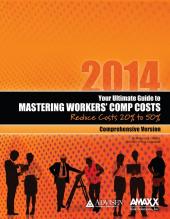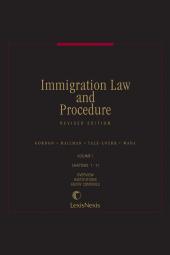Your Ultimate Guide to Mastering Workers Comp Costs: Reduce Costs 20% to 50%
Select a format
 International Order Inquiry
International Order Inquiry
Select subscription type
Terms & conditions
Subscribers receive the product(s) listed on the Order Form and any Updates made available during the annual subscription period. Shipping and handling fees are not included in the annual price.
Subscribers are advised of the number of Updates that were made to the particular publication the prior year. The number of Updates may vary due to developments in the law and other publishing issues, but subscribers may use this as a rough estimate of future shipments. Subscribers may call Customer Support at 800-833-9844 for additional information.
Subscribers may cancel this subscription by: calling Customer Support at 800-833-9844; emailing customer.support@lexisnexis.com; or returning the invoice marked "CANCEL".
If subscribers cancel within 30 days after the product is ordered or received and return the product at their expense, then they will receive a full credit of the price for the annual subscription.
If subscribers cancel between 31 and 60 days after the invoice date and return the product at their expense, then they will receive a 5/6th credit of the price for the annual subscription. No credit will be given for cancellations more than 60 days after the invoice date. To receive any credit, subscriber must return all product(s) shipped during the year at their expense within the applicable cancellation period listed above.
The total price includes the product(s) listed in the Order Form and any Updates for a limited period (minimum period of 30 days) after the order is placed ("Order Window"). Shipping and handling fees are not included in the grand total price.
All shipments may be returned, at subscribers' expense, for full credit of the Price within 30 days of receipt.
Shipments may not be returned, and no credits will be issued, more than 30 days after receipt.
After the Order Window, subscribers will receive notice of Updates along with the then-current grand total price and order process as Updates become available. Subscribers will only be shipped those Updates they specifically request.
Product description
View a sample of this title using the ReadNow feature
“When a workers' compensation maven of Rebecca Shafer's caliber shares her expertise about implementing cost containment best practices, industry professionals can't afford to do anything but listen. Likewise, now that Shafer has released the latest edition of Your Ultimate Guide to Mastering Workers' Comp Costs: Reduce Costs 20% to 50%, risk managers, adjusters, vendors, attorneys, agents and brokers, carriers, and employers can't afford to do anything but purchase the book and start reading. ”
Karen C. Yotis, Esq., author of the website Straight Talk on Insurance at http://www.straighttalkoninsurance.com.
The #1 training manual that covers how to assess your workers' compensation program, design the most cost-impacting strategy, roll out comprehensive changes to your organization, and monitor and manage the program going forward.
The book is based on hands-on experience with industry leaders who have developed programs that reduce workers comp costs 20% - 50% for employers in every industry. The author, Rebecca Shafer, has worked directly with large and small organizations developing practical, cost effective solutions to out of control workers' compensation costs.
This guidebook provides simple to advanced strategies — everything an employer "CAN DO" to reduce costs — an EMPOWERING experience. Learn now with 19 chapters - over 180 pages of cost reduction strategies and techniques.
Chapters include:
• Workers' Compensation Basics
• Fundamentals of Cost Containment
• Training and Building Commitment
• Injury Management Best Practice Roles and Responsibilities
• Reporting the Claim
• Post-Injury Response Procedure
• Communication with Employees
• Working with Insurance Companies or Claim Administrators
• Safety and Loss Control
• Wellness Programs
• Return to Work and Transitional Duty
• Other Indemnity Cost Containment Services
• Directing Medical Care
• Medical Cost Containment
• Fighting Fraud and Abuse
• Rehabilitating the Injured Employee
• Managing Prescription Drug Use and Abuse Program
• Claims Resolution and Settlements
eBooks, CDs, downloadable content, and software purchases are noncancelable, nonrefundable and nonreturnable. Click here for more information about LexisNexis eBooks. The eBook versions of this title may feature links to Lexis+® for further legal research options. A valid subscription to Lexis+® is required to access this content.
Table of contents
Chapter 1: Workers’ Compensation Insurance Basics
Purpose of Workers’ Compensation
Who Pays for Workers’ Compensation
Parties Involved in Workers’ Compensation
Benefits for the Employer
Independent Contractors
Benefits for the Employee
Injuries Covered
Determining Compensability
Aggravation vs Exacerbation
Standard Defenses
Types of Workers’ Compensation Insurance
How Losses Are Categorized
How Losses Are Reported
Reducing Your Premium
Calculating Your Premium
How Mod Affects Your Premium
Good/Bad Mod Examples
Ways to Reduce Your Mod
Unit Statistical Date
Types of Insurance Structures
Voluntary Markets
Alternatives to Voluntary Markets
Collateral Requirements
Chapter 2: Fundamentals of Cost Containment
Reasons Workers’ Compensation Costs Are High
Who Is in Charge
Work Ability Form Properties
Who Is Responsible for Managing Workers’ Compensation Claims
Who Is Responsible for Managing Workers’ Compensation Process
Hidden (Indirect) Costs of Workers’ Compensation
Additional Costs
Calculating Workers’ Compensation Costs
External Obstacles to Cost Control
Internal Obstacles to Cost Control
Chapter 3: Training and Building Commitment
Implementing a Workers’ Compensation Program
Key Training Responsibilities
Management Awareness
Presenting to Supervisors
Conflicting Roles of Supervisors
Supervisors Must Be Involved
Develop Supervisor Guide
Building on Success
Consider Use of Tools
Bringing Employees on Board
Your Company Message
Workers’ Compensation Implementation Timetable
Facilitator’s Training Agenda
Chapter 4: Injury Management Best Practices Roles and Responsibilities
Injury Coordinator Best Practices
Supervisor Best Practices
Employee Best Practices
Middle Manager Best Practices
Risk Manager Best Practices
Medical Department and Medical Director Best Practices
Senior Management Best Practices
Special Investigation Unit Director Best Practices
Legal Department Best Practices
Chapter 5: Reporting the Claim
Immediately Report All Losses
Critical Issues
Reporting Procedure
Intake Procedures
Essential Intake Considerations
Injury Triage
Employer’s First Report of Injury
What Is Included on the FROI
Completing the FROI
Penalties
Chapter 6: Post-Injury Response Procedure
Post-Injury Response Procedure Guidelines
Benefits of a Consistent Post-Injury Response
Post-Injury Response Worksheet
Implementing Post-Injury Response on the Road
Sample Post-Injury Response Procedure
Summary Steps and Format
Chapter 7: Communication with Employees
Proactive Communication
Reactive Communication
Keep Complete Record
Two Types of Communication
Employee Brochure
Meeting with Your Employee
First Day Phone Call
Weekly Contact
Weekly Meeting Guidelines
Scheduling Weekly Meetings
Reducing Attorney Involvement
Chapter 8: Working with Your Insurance Adjusters or TPA
Claims Adjusters
What Is a TPA
Adjuster File Assignments
Dedicated vs Designated Claims Units
Bundled and Unbundled Services
Deductible vs Control
How to Select a TPA
Learning About Your Claim Partners
Preparing for the TPA Visit
Meeting with Your Claims Handler
Chairside Visits
Doing a National Rollout
Vendor Day
Account Handling Instructions
Reviewing Open Claims with the TPA
Reserving Practices
Information Needed to Establish Reserves
Reserve Calculation Worksheets
Reasons Reserves Are Higher Than Expected
Verifying Reserves Accuracy
Plan of Action (POA)
How to Evaluate a TPA
Medical Management Quality Review
Quality Control File Audit
File Reviews and File Audits
Audit Timing
File Review Procedures
File Audit Procedures
File Audit Participants
MD Participation
How to Control Leakage
What Is Leakage
Types of Leakage
Causes of Leakage
Leakage Claim Audits
Leakage Identification Checklist
Chapter 9: Safety and Loss Control
How to Develop an Effective Safety Program
Initial Assessment
Assignment of Roles and Responsibilities
Record Keeping
What OSHA Requires
Select Safety Committee, Chairman, and Recording Secretary
Safety Committee Responsibilities
Safety Committee Meetings
Communication Methods
Conduct a Thorough Workplace Assessment
Hazard Correction/Safety Work Order Tracking System
Develop Written Policies, Procedures, and Programs
Accident Investigation Program
Education and Training: Employees, Supervisors, and Managers
Who Receives Training
Safety Equipment Required Signs
Communicate Safety Often
Safety Awareness Posters
Safe Days Posters
Safety Recognition and Incentive Programs
Employee Screening
Hiring Safe Employees
Job Analysis
Screening Tools
Chapter 10: Wellness Programs
Wellness in the Workplace
Benefits of Wellness Programs
Incentives for Wellness
Negative Effects of NOT Having a Wellness Program
Types of Wellness Programs
Weight Control
Smoking Cessation Programs
Depression/Anxiety Awareness Treatment
Migraine Headache Management
Substance Abuse Treatment
Drug, Alcohol, and Substance Abuse Policy
Drug, Alcohol, and Substance Abuse Testing
Putting Wellness Programs into Practice
Chapter 11: Return to Work and Transitional Duty
Cost Savings
Measuring Effective of Return-to-Work Programs
Transitional Duty Policy Overview
Benefits
Program Goals
Drafting a Transitional Duty Policy
What to Include in a Transitional Duty Policy
Characteristics of Transitional Duty Assignments
Transitional Duty Program Pay Rate
Estimating the Duration of an Injury
Medical Treatment Guidelines
Medical Treatment and Comorbid Conditions
Using Medical Treatment Guidelines
Using Injury Treatment Guidelines to Estimate Cost Savings
Types of Transitional Duty
Modified Duty
Alternate Work
Alternative Off-Site Jobs
Non-Profit, Volunteer, or Charitable Positions
Transitional Duty Tips
Putting Return-to-Work into Action
How to Identify Transitional Duty Jobs
Employees Who Never Return to Work
Overlapping Benefits
Americans with Disabilities Act (ADA) Key Points
Coordinating Workers’ Compensation with Federal and State Leave Statutes
Workers’ Compensation, ADA, and FMLA Interactions
Case Study
Working with Unions
Chapter 12: Other Indemnity Cost Containment Methods
Work Hardening
Independent Medical Evaluations (IME)
Before the IME
Customize Medical Inquiries
Timeframes for Scheduling and Obtaining IME
Functional Capacity Evaluations (FCE)
Retraining Programs
Telephonic Disability Intervention
Translation Services
Transportation Services
Layoff Planning
Chapter 13: Directing Medical Care
Gain Cooperation from Medical Providers
Types of Doctors
Remote Health Services
Methods of Doctor Selection
If the Employer Can Direct Care
If the Employer Cannot Direct Care
Ten Considerations for Your Company Doctor
Eleven Reasons NOT to Select a Doctor
The PRIMARY Treating Physician (PTP)
Understand the PTP’s Perspective
Information You Need from the Doctor
Understanding KEY Medical Injury Terms
California Medical Provider Network (MPN)
Chapter 14: Medical Cost Containment
Medical Cost Containment Services
Utilization Review Accreditation Commission Certification
Preferred Provider Organizations
Injury Triage
Telephonic Nurse Case Management (NCM)
Field Case Management (FCM)
Mental Health Registered Nurses
Chronic Pain Programs
An Aging Workforce
Medical Review
Medical Advisors and Medical Directors
Independent Medical Evaluation (IME)
Durable Medical Equipment (DME)
At-Home Recovery Services
Medical Bill Review
Medical Fee Schedules
Usual and Customary
Hospital Bill Reviews
Using a Diagnosis Related Groups (DRG) Review Company
Cost Savings Using DRG
Medical and Hospital Bill Review Considerations
Chiropractic Care
Chapter 15: Fighting Fraud and Abuse
When to Investigate a Claim
Types of Investigation
Red Flags of Fraud
Medical Terminology Used to Identify Malingering
Important Times to Use Surveillance
How to Use the Results
When Not to Use Investigation
Reviewing Investigation Reports and Videos
Avoid "Good Day/Bad Day" Syndrome
Additional Fraud Controls
Chapter 16: Rehabilitating the Injured Employee
What Is Physical Therapy
What Is Physical Rehabilitation
What is Occupational Therapy
What is Vocational Rehabilitation
Provider Differences
Physical Therapy
Physical Therapy Management
Determining Rehabilitation Needs
Reasons for Physical Therapy
Measuring Outcomes
Doctor’s Reevaluation
Determining Therapy Outcomes
Physical Therapy Settings
Physical Therapy Office Characteristics
Physical Therapy Cost
Physical Rehabilitation
Physical Rehabilitation Networks and Specialties
Medical Assessments
Cost of Physical Rehabilitation
Physical Rehabilitation Facilities
Measuring Physical Rehabilitation Outcomes
Occupational Therapy
Occupational Therapy Management
Role of the Occupational Therapist
Use Occupational Therapy When
Vocational Rehabilitation
Use Vocational Rehabilitation When
Managing the Vocational Rehabilitation Process
Chapter 17: Managing Prescription Drug Use and Abuse
Pharmacy Benefits Managers
Reasons to Use Pharmacy Benefits Management
Prospective and Retrospective Components
Proactive Drug Management Techniques
Authorized Drug Formulary
Narcotics for Pain Control
Cognitive Behavior Therapy
Pharmacogenetics Testing
Addiction Networks
Reviewing Your Program
Key Selection Criteria for a PBM
Prescription Drug Monitoring Programs
Toxicology Screening
Implementing the Program
Chapter 18: Claims Resolution and Settlements
When and How to Settle a Workers’ Compensation Claim
Action Plan
Disability Rated Losses
Disability Scheduled Losses
Jurisdictional Issues
Local Influences
Include Future Medical in the Settlement
Selecting Physicians to Obtain a Fair Disability/Permanency Rating
Challenging Impairment Ratings
Medical Issues
Disputed Issues
Offsets Against Other Payments
Social Security Disability Benefit Offsets
Social Security Reverse Offsets
States With Reverse Offset
Prior Injury Offsets
Subrogation
Pre-existing Conditions and Second Injury Funds
Availability of Future Employment in the Marketplace
Voluntary Resignations
Strengths and Weaknesses of Both Sides
Negotiations
Waivers and Releases
Include Medicare in Release
Medicare Set-Asides
Conditional Payment and Final Demand
Pharmacy Component of Medicare Set-Asides
Structured Settlements and Annuities
Structured Settlement Benefits
Structured Settlement Vendor Selection Criteria
California Settlement Process
Chapter 19: Federal Employees Compensation Act
Federal Employees and Workers’ Compensation
Paying for FECA Costs
Administering FECA Claims
Selection of Medical Providers
Medical Benefits
Lost Wages Federal Employees Receive
Permanent Disability or Death
Registering as a Federal Medical Provider
Challenges in Controlling Costs
Traditional Cost Control Techniques
Independent Medical Examinations
Cost Containment Vendors and Services
Gaining Management Commitment
Return-to-Work Programs
Federal Employees Return-to-Work: Transitional Work (before Maximum Medical Improvement)
Defining and Determining Maximum Medical Improvement
Transitional Duty Work and Assignment
Transitional Duty Barriers Checklist
Role of the DOL in Transitional Work
Federal Employees Return-to-Work: Alternative Work (after Maximum Medical Improvement)
Alternative Employment
Vocational Rehabilitation and Retraining
Difference Between an Impairment and a Disability
Appendix A: Glossary of Abbreviations
Appendix B: Documents Referenced in Book
INDEX
 Lexis Nexis
Lexis Nexis 


